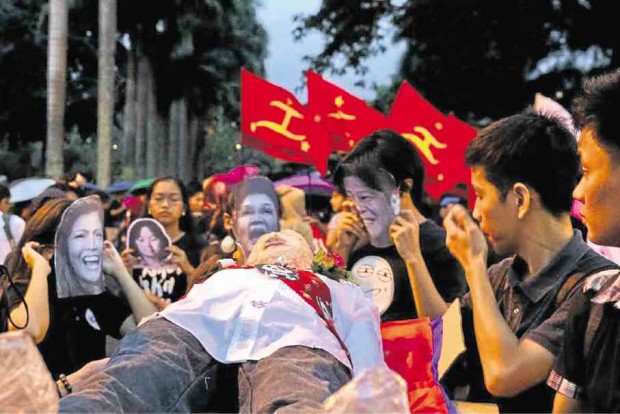
Students, some of them wearing masks of Marcos family members, parade an effigy of the late strongman Ferdinand Marcos during the “Black Friday” protest held last month at the University of the Philippines campus in Los Baños, Laguna. —CHRIS QUINTANA / CONTRIBUTOR
SAN PEDRO CITY—Jessica Sales taught social sciences at the University of the Philippines Los Baños (UPLB) in Laguna province, taking her master’s degree in the College of Agriculture at the same time.
As a teacher, she was known to have encouraged discussions in class, particularly about the political situation under martial law.
On July, 31 1977, Sales disappeared, along with activists and students Rizalina Ilagan, Bong Sison, Ramon Jasul, Cristina Catalla, and Gerardo Fautistino.
There was no official record of their arrests. Their bodies were never found.
“They disappeared in one fell swoop. Gerardo was even my room mate,” said Monnie Nolasco, a lawyer and martial law activist.
Nolasco, chair of the UPLB Student Council when it was established in 1978, narrowly escaped arrests during the Marcos regime.
One time was when the military raided the Student Union building where they often held their meetings.
Stories of atrocities, warrantless arrests and torture were recalled during a cultural night on Thursday at the UPLB campus.
Students, teachers and professionals, who opposed the burial of the strongman Ferdinand Marcos at Libingan ng mga Bayani, revived a “long overdue” plan to erect a memorial for the victims of rights abuses in UPLB.
“It was revolting. It was like spitting on our faces,” Nolasco said of the hero’s burial for Marcos.
But this, he said, also brought together the anti-Marcos victims from UPLB, “now, with much fervor,” to push the initiative.
“So far we have counted six [names of those slain during martial law] and six desaparecidos (victims of forced disappearance),” Nolasco said in a telephone interview last week.
The plan to build a hero’s monument in honor of UPLB’s “homegrown” martyrs was in accordance with Republic Act No. 10368 that seeks the “reparation and recognition” of human rights victims.
Nolasco said it will be patterned after the Bantayog ng mga Bayani in Quezon City and will be unveiled by early 2017, in time for the anniversary of the First Quarter Storm, a series of student-led demonstrations in 1970.
He said they chose to put the memorial inside the UPLB campus to serve as a reminder to students of UPLB’s contributions in the fight for democracy.
“After all, that’s what we are taught in UP, being the premier university: nationalism, dedication and volunteerism,” he said.